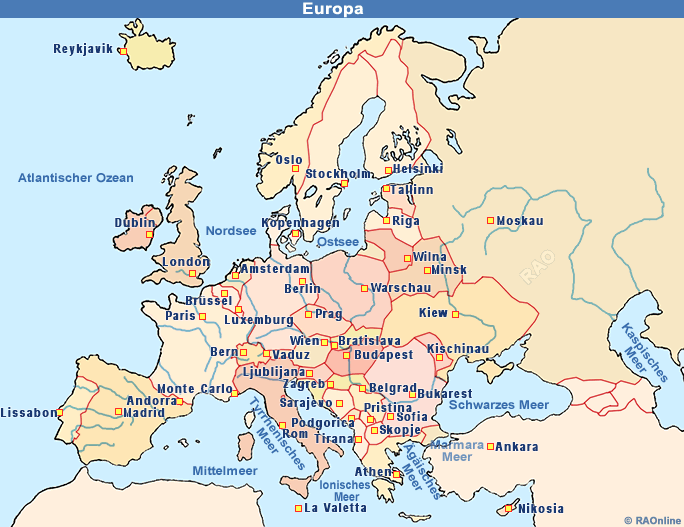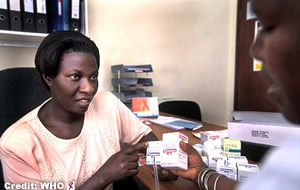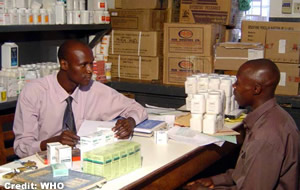 |
Gesundheit AIDS-HIV Deutschland |
 |
 |
Gesundheit Weitere Informationen |
|
| Welt-AIDS-Tag 2016 |
 |
|
Neue Schätzung zu HIV/AIDS in Deutschland |
 |
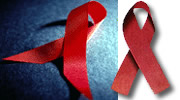 |
"HIV/AIDS ist weiterhin ein Gesundheitsrisiko in Deutschland", das betont Lothar H. Wieler, Präsident des Robert Koch-Instituts, anlässlich der neuen RKI-Schätzung zum HIV/AIDS-Geschehen in Deutschland. Demnach lebten Ende 2015 rund 84'700 Menschen in Deutschland mit HIV. Etwa 3'200 Menschen haben sich in Deutschland 2015 neu mit HIV-infiziert, die Zahl ist gegenüber den Vorjahren unverändert. |
"Das ist eine auch im Vergleich zu vielen anderen Staaten positive Nachricht, aber andererseits ist der ausbleibende Rückgang ein Beleg dafür, dass die HIV-Präventionsstrategie der Bundesregierung weiterhin konsequent umgesetzt werden muss", unterstreicht Wieler.
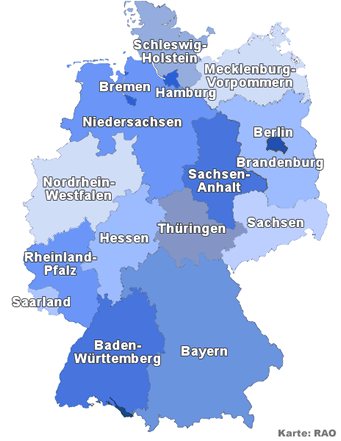 |
Die am stärksten von HIV betroffene Gruppe sind weiterhin Männer, die Sex mit Männern haben (MSM). Von den 3'200 Neuinfektionen im Jahr 2015 erfolgten 2'200 bei MSM, diese Zahl sinkt seit einigen Jahren leicht, 750 wurden auf heterosexuellem Wege übertragen, 250 bei intravenösem Drogenkonsum. Im Jahr 2015 gab es geschätzte 460 Todesfälle bei HIV-Infizierten.
Von den 84'700 HIV-Infizierten wissen geschätzte 12'600 nichts von ihrer Infektion. Mit Spätdiagnosen sind höhere Sterblichkeit und Behandlungskosten verbunden; zudem kann die Infektion unbeabsichtigt weitergegeben werden. Daher müssen Barrieren für die Testung auf HIV und andere sexuell übertragene Infektionen identifiziert und abgebaut werden. Ungefähr 60'700 HIV-Infizierte werden mit antiviralen Medikamenten behandelt. Daraus lässt sich ableiten, dass fast 11'000 HIV-Infizierte zwar von ihrer Infektion wissen, aber keine Medikamente nehmen. Zugangsbarrieren müssen daher erkannt und beseitigt werden. |
|
Unter den 84'700 Menschen mit HIV in Deutschland sind etwa 11'750 Personen mit einer Herkunft aus dem Ausland, die sich auch im Ausland mit HIV infiziert haben. Die grösste Gruppe sind 6'300 in Afrika erworbene Infektionen, hier dominieren Infektionen über heterosexuelle Kontakte, bei den 2'700 in anderen Ländern Europas erworbenen Infektionen dominieren MSM und intravenös Drogen Gebrauchende, die übrigen Infektionen wurden in Asien, Amerika und Australien erworben.
Die Empfehlung, Kondome zu verwenden, bleibt Grundpfeiler der HIV-Prävention und hat nichts an Aktualität verloren.
Die Schätzung der Zahl der HIV-Neuinfektionen erfolgt in jedem Jahr neu. Durch zusätzliche Daten und Informationen sowie Anpassung der Methodik können sich die Ergebnisse der Berechnungen von Jahr zu Jahr verändern und liefern jedes Jahr eine aktualisierte Einschätzung des gesamten bisherigen Verlaufs der Epidemie. Die jeweils angegebenen Zahlenwerte können daher nicht direkt mit früher publizierten Schätzungen verglichen werden. Die geschätzten Neuinfektionen sind nicht zu verwechseln mit den beim RKI gemeldeten Neudiagnosen. Da HIV über viele Jahre keine auffälligen Beschwerden verursacht, kann der Infektionszeitpunkt länger zurückliegen.
Die neue Schätzung ist im Epidemiologischen Bulletin 45/2016 veröffentlicht, die Eckdaten liegen auch für die einzelnen Bundesländer vor und sind online abrufbar.
nach oben
| 1 in 7 people living with HIV in the EU/EEAare not aware of their HIV status |
 |
 |
Almost 30 000 newly diagnosed HIV infections were reported by the 31 European Union and European Economic Area (EU/EEA) countries in 2015, according to data published today by ECDC and the WHO Regional Office for Europe. |
This is similar to the observed notification trends in the last decade. One reason for this persistent HIV epidemic: ECDC estimates that currently around 122 000 people living with HIV across the region are unaware of their infection. The estimated time between HIV infection and diagnosis is four years.
Almost 30 000 newly diagnosed HIV infections were reported by the 31 European Union and European Economic Area (EU/EEA) countries in 2015, according to data published today by ECDC and the WHO Regional Office for Europe. This is similar to the observed notification trends in the last decade. One reason for this persistent HIV epidemic: ECDC estimates that currently around 122 000 people living with HIV across the region are unaware of their infection. The estimated time between HIV infection and diagnosis is four years.
With 29 747 newly reported HIV infections in 2015, the EU/EEA notification rate is similar to recent years with an overall insignificant change from 6.6 per 100 000 population in 2006 to 6.3 in 2015 (adjusted for reporting delay).
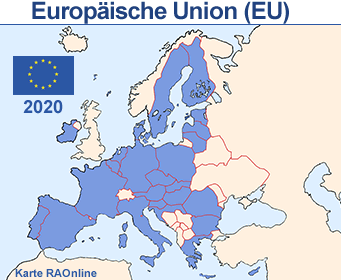 |
| European Commissioner for Health and Food Safety, Vytenis Andriukaitis, said: "HIV/AIDS continues to be a serious problem in Europe. The Commission is committed to helping Member States reach the SDG target of ending HIV/AIDS and Tuberculosis by 2030 and reducing Hepatitis, as underlined a few days ago in our Communication for a sustainable European future. ECDC's estimate that one in seven people living with HIV are unaware of their status is particularly worrying: people who do not know they are infected cannot benefit from life-saving treatment, and can continue to transmit the virus to others. This is why easy and accessible testing is so important. |
|
The European Commission supports HIV testing by working together with Member States and civil society on joint projects, funded by the EU Health Programme, on prevention and linkage to care."
"The facts we know about the HIV epidemic in the EU/EEA, are based on the number of new diagnoses reported each year, which represents the cornerstone of European HIV surveillance", explains ECDC Acting Director Andrea Ammon. "But we also know that these figures do not reflect the true picture. ECDC estimates that currently around 122 000 people in the EU/EEA are infected with HIV but are not aware of their infection - that is every 1 in 7 people living with HIV in the region."
If diagnosed and treated early enough, people can live long and healthy lives with HIV. "To reach the estimated 15% who are not aware of their infection, we need to increase efforts to promote and facilitate more testing for HIV. And link those diagnosed to care. A simple and quick blood test allows people to determine their HIV status. It's best to know your HIV status so you can take care of your own health - and also protect others", stresses Ammon.
"ECDC is currently supporting Member States to standardise and improve their national estimates regarding the number of people living with HIV. This should lead to a more effective HIV response, because it enables better targeting of resources at the populations they identify as being most at risk in that country."
"Despite significant efforts, HIV remains among the main public health concerns in the WHO European Region, in particular in its eastern part. 2015 recorded the highest number of new cases in one year, contributing to an appalling 2 million cumulative cases", says Zsuzsanna Jakab, WHO Regional Director for Europe.
"To address this critical situation, we have made available a new action plan that all European countries endorsed in September 2016. We now call on countries' leaders to use this plan for an urgent, accelerated and innovative response to HIV in the Region, to reverse the AIDS epidemics immediately and end it by 2030".
In the EU/EEA, sex between men is still is the main reported HIV transmission mode, accounting for 42% of all notified HIV diagnoses in 2015 and for more than half of new diagnoses in 15 countriesi. Men who have sex with men are the only group in the EU/EEA that has seen a steady increase in notifications over the years. With 32% of reported HIV diagnoses, sex between women and men is the second most commonly reported mode of transmission in the EU/EEA, followed by injecting drug use (4%).
Time between infection and diagnosis in the EU/EEA: four years
The new surveillance data also show that almost every second (47%) HIV positive person in the EU/EEA is diagnosed at a late stage of infection. The new ECDC estimate revealed that, on average, it takes almost four years (3.8) before an HIV infection is diagnosed and reported. This again suggests persistent problems with access to, and uptake of, HIV testing in many countries.
The European Test Finder makes it easy to locate an HIV testing site in Europe: all that is needed is a post code or city name to find the nearest test centre. This year's updated version also includes places for STI and hepatitis testing. In addition, available ECDC Guidance and results from monitoring the Dublin Declaration on Partnership to Fight HIV/AIDS in Europe and Central Asia assist Member States in their HIV response.
iAustria, Croatia, Cyprus, the Czech Republic, Germany, Greece, Hungary, Ireland, Malta, the Netherlands, Poland, Slovakia, Slovenia, Spain and the United Kingdom
nach
oben
| Reports on the global AIDS epidemic |
 |
 |
Externe Links |
|



